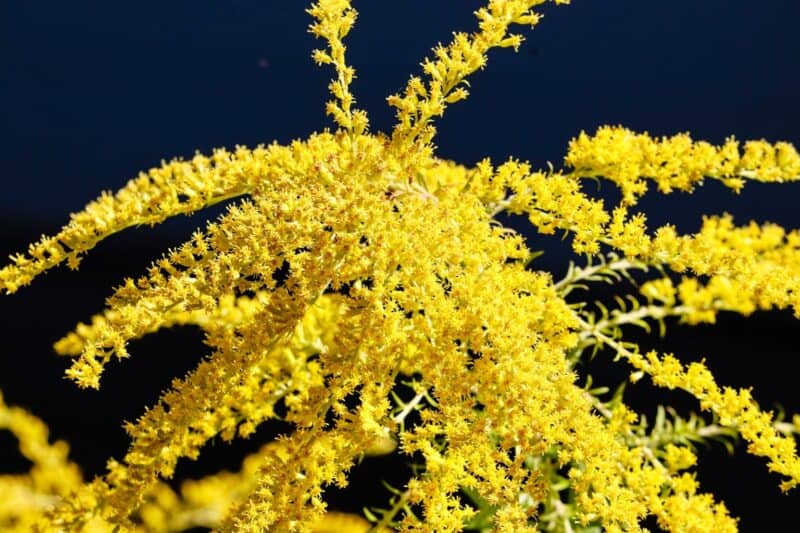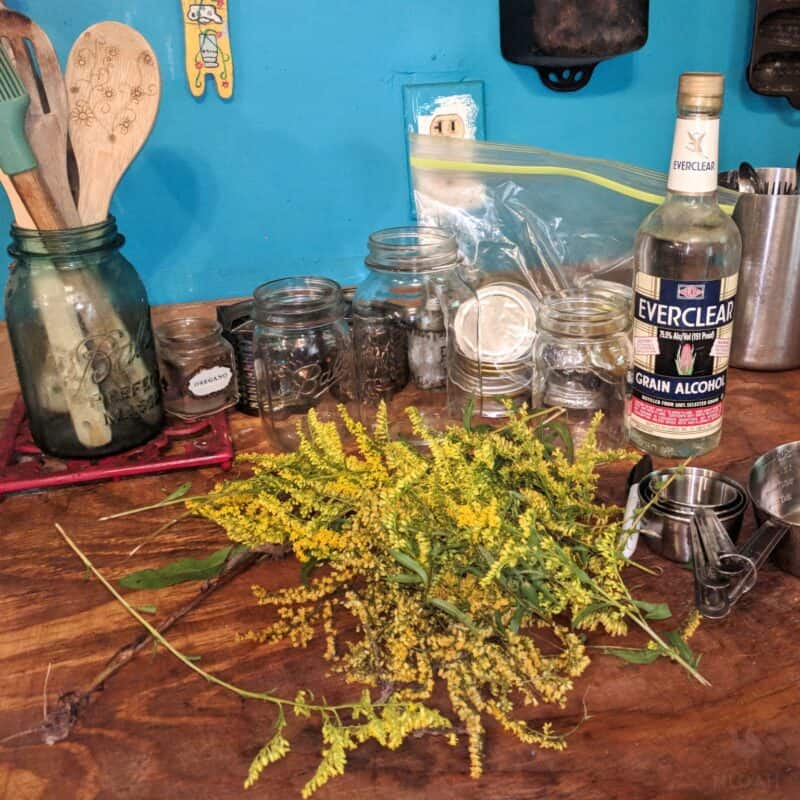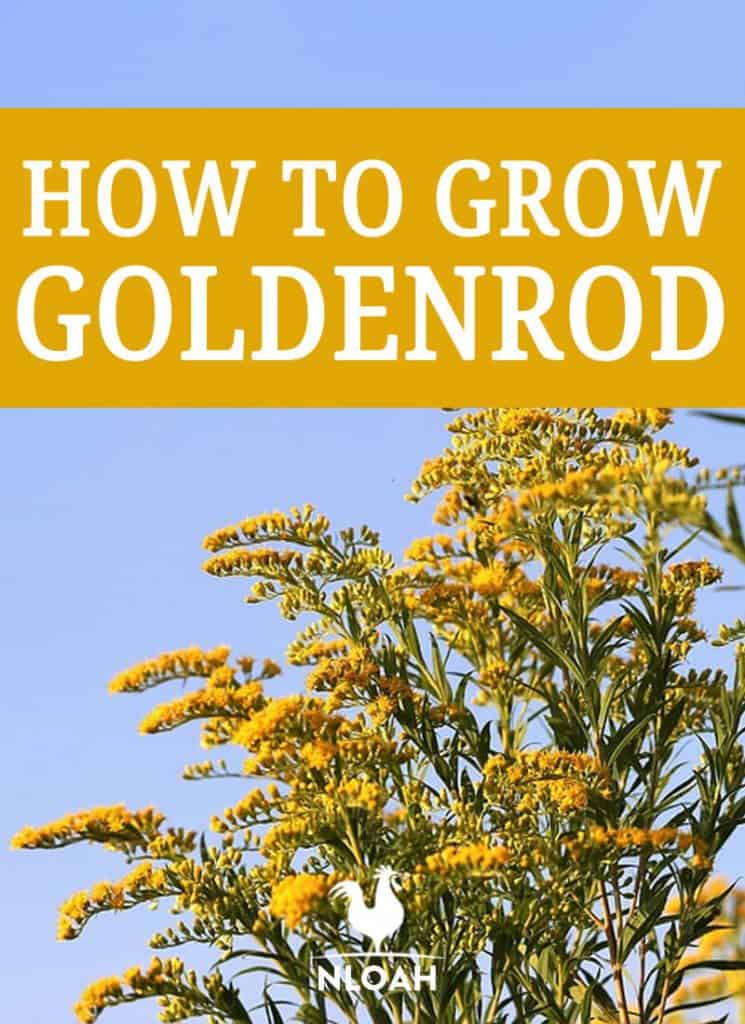Goldenrod is largely thought of as an annoying weed that makes you sneeze in the United States. But in Europe, this edible and naturally healing plant is cultivated alongside more conventional garden plants for its beauty. There are 130 different species of goldenrod, all of which can be foraged and used in wildcrafting home remedies.

Far too often goldenrod is blamed for hay fever and all of the frustrating symptoms that come along with it. In all actuality, even though folks can be allergic to goldenrod, it is typically ragweed that grows alongside it, that causes all of the sneezing and itchy watery eyes.
The pollen on goldenrod plants is dense and is rarely ever carried away by the wind but is instead packed away in smaller bunches by insects.
Goldenrod is an exceptionally hardy plant, hence why it can grow even amid cracks in the pavement in the harshest of city environments. If you are homesteading in an urban area, the sleek goldenrod plant might be a perfect “weed” to add to your garden plan.
The Solidago genus, all 60 to 130 species of it, are basically all referred to as goldenrod – even though they each have their own names too. Woundwort, heathen wound herb, Aaron’s rod, and blue mountain tea are some of the other most common species of the aster family that are routinely referred to as simply goldenrod.
Goldenrod Hardiness
Goldenrod prefers to grow in areas that are full sun. This is why you see them popping up along the roadside, in livestock pastures, and hayfields. They are not picky about the soil type, and are fully capable of thriving in dirt that many other plants refuse to grow.
After a wildfire sweeps through a rural area, goldenrod is generally the first signs of new growth that appear. Even urban sprawl cannot keep goldenrod down for long. These diligent growers will continue to pop up in any concrete crack that forms and even in trash ridden vacant lots.
Goldenrod Varieties
Growing a goldenrod variety that is native to your region of North America further enhance your chances of success.
- S. caesia or blue-stemmed goldenrod and S. nemoralis or gray goldenrod grow the best in eastern states.
- S. juncea or early goldenrod also thrives in eastern regions and boasts delicate and bright blossoms that are very often used in natural dyes and other decorative crafts.
- S. speciosa or showy goldenrod and S. canadensis or Canada goldenrod both grow well in northern states.
- Zigzag or S. flexicaulis typically grows to a bit shorter height than other varieties of goldenrod and does so in a zigzag style pattern.
- S. nemoralis or Old-field goldenrod boasts a flower head that is more of a cylinder in shape than the typical tuft style most commonly associated with the plant. Old-field goldenrod also grows to a slightly shorter height than many other wild varieties of the plant.
- Swamp Bog goldenrod or S. uliginosa thrives best in wet soil or swamp-like areas.
- S. sempervirens or Seaside goldenrod is a salt tolerant variety of the plant, and can vary greatly in height. Seaside goldenrod can be found in beachy regions as short as only 1 foot tall or proudly standing about 8 feet tall.
- Woundwort or S. virgaurea grows best in dry areas and on high ground.
- S. bicolor or white goldenrod is perhaps the most unique variety of the plant. It does not have the distinctive bright yellow flowers like all of the other varieties, but white ones. White goldenrod is also among the shorter varieties of this wild edible and medicinal plant.
- Mountain tea or sweet goldenrod is favored by many herbalists in natural remedies and does well even in colder climates. Native Americans also had an affinity for mountain tea and used it as a flavoring in many otherwise bitter tasting medicinal remedies.
Goldenrod has been dubbed the most patriotic plant in America. In 1773, after the Boston Tea Party, American colonists began brewing Liberty Tea as a substitute for the tea from China. Liberty Tea was made from equal parts of red cover, betony, and sweet goldenrod flowers.
After the Revolutionary War was over, goldenrod became so popular it was even shipped from America to China and sold as a high-end substitute for tea.
If you want to brew goldenrod tea, harvest the leaves in late July before the plant comes into bloom to avoid a slightly bitter taste. Hang dry stalks with leaves intact or dehydrate the leaves.
Once the leaves become crisp, they can be stored in a Mason jar with a firm-fitting lid out of direct sunlight. Use about 1 teaspoon of dried leaves in 1 cup of water – steeping them for about 5 minutes, and sweeten to taste.
How to Grow Goldenrod
Purchase goldenrod seed or harvest your own in mid-August. Goldenrod plants can also be purchased at nurseries in some areas or online. Although goldenrod is not picky about its soil type, I recommend planting both seeds or plants in a well-draining soil that is only slightly acidic and humusy.
On our homestead one of the most robust patches of wild goldenrod grow profusely every year in clay soil.
These wildflowers prefer full sun but most varieties can be grown in partial shade. Typically, all species of goldenrod can grow to reach about five feet tall. Some varieties grow taller and can become uncommonly bushy.
There is no need to use any type of fertilizer when cultivating goldenrod; doing so could actually cause this rapid grower to become spindly. Butterflies, honey bees, and beneficial insects love goldenrod, they will likely be all of the growing help that you need.
If you harvest your seeds from a wild plant, they will most likely be of the sweet goldenrod variety, it is the most prevalent found throughout America. Goldenrod blooms from August through October in the wild. The plants are hardy in agricultural zones 2 through 9.
- When cultivating goldenrod from seeds, stratify them for approximately 3 months and only them surface sow them onto the soil after the danger of the last hard frost has passed.
- Nursery plants or cuttings should also be planted in the spring. They will develop six nodes by the end of the season when they are progressing properly and taking root.
- During the weeks of the late spring through the early summer, divide up any rooted plants being started in container pots or a raise bed and transplant them individually in a permanent location.
- About once every five years plan on dividing clumps of goldenrod to thin them out. You can take cuttings in the spring and replant them elsewhere in your growing patches.
- When planting seeds or nursery plants in the spring, I recommend simply putting a light mound of quality compost around the goldenrod to get them off to a good start – helping to protect them from an unseasonal cold snap in the process.
- Once you get a patch of goldenrod established, it should come back year after year. This plant is perfect for a novice gardener because it is extremely drought tolerant and requires extremely little watering – if any.
Goldenrod Disease, Pests, and Invasiveness
- Goldenrod plants are very hardy against all common native destructive insects. Rarely will you encounter damage on the flowering heads of a goldenrod plant.
- The galls that you may seem form on the stems, or swollen and rounded growths, are caused by insect visitations but do not cause any harm to the growing plant.
- They are also hardy against common diseases that can afflict other wild and conventional plants and herbs. Powdery mildew is perhaps the only plant disease you should be on the lookout for when growing or foraging goldenrod.
I am sure you have heard (or uttered) the phrase, “growing like a weed.” Goldenrod definitely lives up to this old adage. When left unchecked, goldenrod can grow aggressively and spread into areas that you did not intend.
Goldenrod uses underground rhizomes to ressed, which serves to increase its invasive nature. Transplanting goldenrod often or using man-made barriers like decorative fencing or natural barriers like dense shrubbery, will help keep goldenrod in check.
Once goldenrod is established in an area it begins to make itself quite at home, and can quickly process to take over the entire space. If you harvest flower heads before they have the chance to go to seed, this will also help stop the rapid spreading and provide you with matter for foraging recipes and natural home remedies.

How to Harvest Goldenrod
Harvesting goldenrod leaves and flowers right before or as they come into bloom is highly recommended. This will prevent them from going to seed and spreading, and help preserve the fairly sweet taste of the goldenrod plant. All above ground portions of the plant can be wildcrafted.
To harvest goldenrod, just use a pair of scissors to snip away the part of the plant that you want or your hands to break the portion of the plant desired from itself or the ground.
Goldenrod care is minimal once established in the landscape, with plants returning each year. They require little, if any watering, and are drought tolerant. Clumps need division every four to five years. Cuttings may also be taken in spring and planted in the garden.


Tara lives on a 56 acres farm in the Appalachian Mountains, where she faces homesteading and farming challenges every single day, raising chickens, goats, horses, and tons of vegetables. She’s an expert in all sorts of homesteading skills such as hide tanning, doll making, tree tapping, and many more.

I have goldenrod growing in a big pot right now. Have been eating leaves, a few at a time in green smoothies and cooked greens. Am experimenting with macerating some flowers in oil this year, to use on the skin as is, or in homemade lotion.
I always enjoy your sharing! Thank you, Tara!!
Hi Tara,
I had to read this, because I live in England now, but grew up in NJ. When I first moved over here, I was afraid to help with the garden, because most of what I knew as weeds in NJ was sold for a lot of money in little pots here!!! Go into a fancy garden center, and you can find Goldenrod, Summach, and more for sale! What blew my mind even more was going to the French countryside and seeing a field of Dandelions! Yep, planted on purpose! They eat them with bacon!